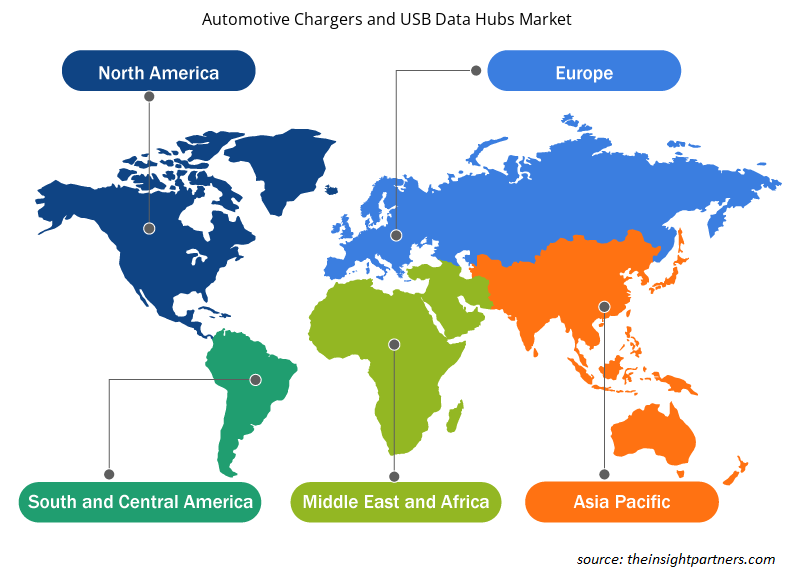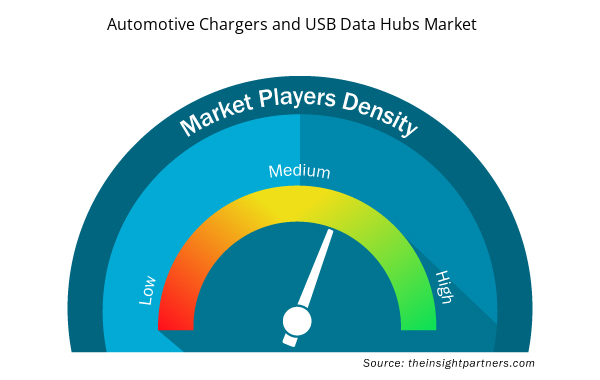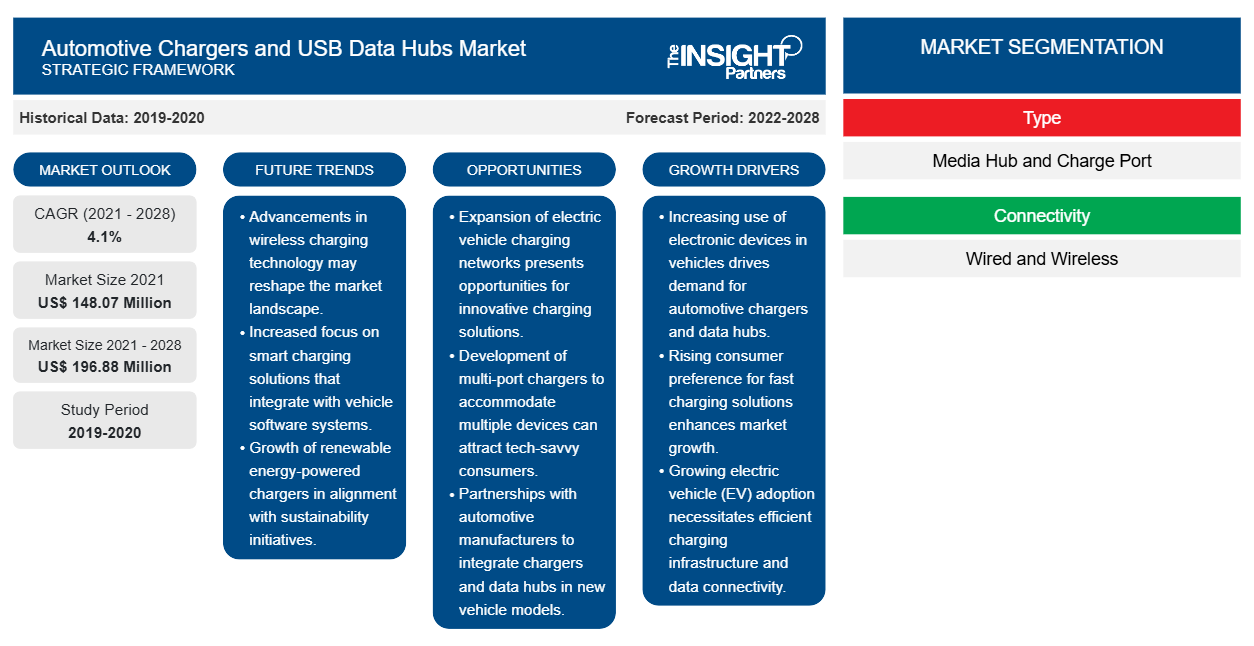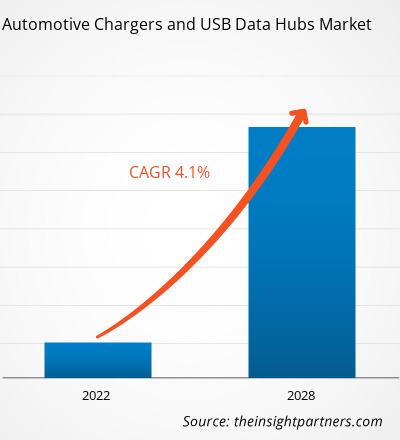Si prevede che il mercato dei caricabatterie per autoveicoli e degli hub dati USB crescerà da 148,07 milioni di dollari nel 2021 a 196,88 milioni di dollari entro il 2028; si stima che crescerà a un CAGR del 4,1% nel periodo 2021-2028.
La crescente popolarità dei sistemi di assistenza alla guida (DAS) sta attirando l'attenzione delle aziende automobilistiche verso l'automazione dei veicoli. I produttori stanno creando veicoli integrati con sistemi di intrattenimento superiori in risposta alla crescente preferenza per veicoli sicuri, lussuosi e intelligenti. I produttori di accessori per automobili hanno risposto sviluppando sofisticati sistemi USB per una migliore esperienza in-vehicle. Jumplux Technology Co., Ltd. offre SPD102 – USB2.0 MEDIA HUB SOC. SPD102 è un hub USB 2.0 ad alta velocità con due porte downstream e un lettore di schede. A differenza di un normale hub USB, l'hub USB SPD102 supporta carplay, che consente ai dispositivi iOS di comunicare con il display integrato delle unità principali del veicolo, quando sono collegati tramite USB. Sulle porte downstream, è supportata anche la specifica di ricarica della batteria USB-IF versione 1.2 (BC 1.2). Inoltre, l'assistenza al parcheggio, la navigazione predittiva, la pianificazione pre-viaggio, la sincronizzazione abilitata al cloud e altre funzionalità critiche vengono implementate da aziende di infotainment tecnologicamente sofisticate. Inoltre, i clienti possono visualizzare la propria lista contatti, i registri delle chiamate e leggere i messaggi tramite l'hub USB. Con la crescente integrazione degli smartphone con i sistemi di infotainment delle auto, il numero di persone che acquistano un veicolo di fascia alta con sistemi di intrattenimento wireless e moderni è in aumento. Pertanto, il rapido aumento della produzione di sistemi di infotainment ad alta risoluzione per una migliore esperienza utente, in risposta alla crescente preferenza per i sistemi di infotainment e DAS, sta contribuendo alla crescita del mercato dei caricabatterie per auto e degli hub USB dati .
Personalizza questo report in base alle tue esigenze
Riceverai la personalizzazione gratuita di qualsiasi report, comprese parti di questo report, o analisi a livello nazionale, pacchetto dati Excel, oltre a usufruire di grandi offerte e sconti per start-up e università
- Scopri le principali tendenze di mercato in questo rapporto.Questo campione GRATUITO includerà analisi di dati che spaziano dalle tendenze di mercato alle stime e alle previsioni.
Impatto della pandemia di COVID-19 sul mercato dei caricabatterie per autoveicoli e degli hub dati USB
Secondo l'ultimo rapporto sulla situazione dell'Organizzazione mondiale della sanità (OMS), Stati Uniti, Spagna, Italia, Francia, Germania, Regno Unito, Russia, Turchia, Brasile, Iran e Cina sono alcuni dei paesi più colpiti a causa dell'epidemia di COVID-19. La crisi del COVID-19 sta colpendo le industrie in tutto il mondo e si prevede che l'economia globale subirà il colpo peggiore nel 2020 e probabilmente nel 2021. L'epidemia ha creato notevoli interruzioni nei settori primari come cibo e bevande, energia ed energia, elettronica e semiconduttori e prodotti chimici, nonché nell'automotive. Un forte calo delle attività di produzione dell'automotive ha avuto un impatto negativo sulla crescita del mercato globale dei caricabatterie per auto e degli hub dati USB.
Le chiusure delle fabbriche, i divieti di viaggio, i divieti commerciali e i blocchi delle frontiere per combattere e contenere l'epidemia hanno avuto un impatto sulla produzione, la fornitura e la vendita di vari componenti elettronici necessari per la produzione di caricabatterie per auto e porte USB. L'impatto stimato dell'epidemia di COVID-19 sulla crescita del mercato globale dei caricabatterie per auto e degli hub dati USB in vari paesi/regioni è descritto di seguito.lockdowns to combat and contain the outbreak have impacted manufacturing, supply, and sales of various electronic components that are required for the manufacturing of car chargers and USB ports. The estimated impact of COVID-19 outbreak on the growth of global automotive chargers and USB data hubs market in various countries/regions is described below.
Approfondimenti sul mercato dei caricabatterie per auto e degli hub dati USB
L'aumento della produzione automobilistica alimenta la crescita del mercato dei caricabatterie per autoveicoli e degli hub dati USB
Le vendite di automobili stanno raggiungendo nuovi picchi grazie alla crescente popolarità di camion e SUV e alla crescente domanda di berline compatte. Per una manciata di case automobilistiche, le vendite sono aumentate a due cifre, con le consegne totali di Tesla più che triplicate rispetto al primo trimestre dell'anno scorso. Toyota, Hyundai, Nissan, Subaru e Kia hanno tutte segnalato aumenti delle vendite a due cifre. Nel 2020, saranno prodotti 78 milioni di veicoli a livello globale. Questo numero riflette un calo del 15 percento rispetto all'anno precedente. Nel 2020, Cina, Giappone e Germania sono stati i principali produttori di automobili e veicoli commerciali. Con volumi di produzione di veicoli così enormi, anche la necessità di accessori per automobili è in aumento. L'elevata attenzione dei consumatori per i pratici sistemi di infotainment nei veicoli e la crescente popolarità dei dispositivi personali stanno aumentando la crescita del mercato dei caricabatterie per automobili e degli hub USB dati.
Molti paesi nel mondo hanno fissato obiettivi che enfatizzano la riduzione delle emissioni delle auto. Come parte di ciò, hanno iniziato a promuovere la produzione e la commercializzazione di veicoli elettrici e delle relative infrastrutture di ricarica. Nel 2017, il governo degli Stati Uniti ha speso 5 miliardi di dollari per migliorare l'infrastruttura delle auto elettriche, comprese le stazioni di ricarica. Diversi governi stanno offrendo incentivi, tra cui costi di immatricolazione bassi o nulli, nonché esenzioni dalle imposte sulle importazioni, dalle imposte sulle vendite e dalle tasse di circolazione. Inoltre, Norvegia e Germania stanno investendo molto nella promozione delle vendite di veicoli elettrici. Pertanto, l'impennata della produzione automobilistica, con la crescente attenzione ai veicoli elettrici, sta rafforzando la crescita del mercato dei caricabatterie per auto e degli hub USB dati.
Approfondimenti di mercato basati sul tipo
In base al tipo, il mercato dei caricabatterie per auto e degli hub dati USB è diviso in hub multimediali e porte di ricarica. Nel 2020, il segmento delle porte di ricarica ha rappresentato una quota di mercato maggiore.
Approfondimenti di mercato basati sulla connettività
In base alla connettività, il mercato dei caricabatterie per auto e degli hub dati USB è segmentato in cablato e wireless. Nel 2020, il segmento cablato ha rappresentato una quota di mercato maggiore.
I player che operano nel mercato dei caricabatterie per auto e degli hub dati USB adottano strategie quali fusioni, acquisizioni e iniziative di mercato per mantenere le loro posizioni nel mercato. Di seguito sono elencati alcuni sviluppi dei player chiave:
- A febbraio 2020, Aircharge sarà lieta di esporre i tavoli di ricarica wireless come parte dello stand dei fornitori alberghieri alla convention Hotel, Restaurant and Catering (HRC), che si terrà all'ExCel di Londra dal 3 al 5 marzo 2020.
- Nell'agosto 2019, Microchip ha annunciato due nuove soluzioni che semplificano la progettazione di USB Type-C PD, eliminando la tradizionale complessità e gli elevati costi associati all'implementazione di USB Type-C in una vasta gamma di applicazioni.
Approfondimenti regionali sul mercato dei caricabatterie per autoveicoli e degli hub dati USB
Le tendenze e i fattori regionali che influenzano il mercato dei caricabatterie per auto e degli hub dati USB durante il periodo di previsione sono stati ampiamente spiegati dagli analisti di Insight Partners. Questa sezione discute anche i segmenti di mercato dei caricabatterie per auto e degli hub dati USB e la geografia in Nord America, Europa, Asia Pacifico, Medio Oriente e Africa e America centrale e meridionale.

- Ottieni i dati specifici regionali per il mercato dei caricabatterie per autoveicoli e degli hub dati USB
Ambito del rapporto di mercato sui caricabatterie per autoveicoli e sugli hub dati USB
| Attributo del report | Dettagli |
|---|---|
| Dimensioni del mercato nel 2021 | 148,07 milioni di dollari USA |
| Dimensioni del mercato entro il 2028 | 196,88 milioni di dollari USA |
| CAGR globale (2021 - 2028) | 4,1% |
| Dati storici | 2019-2020 |
| Periodo di previsione | 2022-2028 |
| Segmenti coperti | Per tipo
|
| Regioni e Paesi coperti | America del Nord
|
| Leader di mercato e profili aziendali chiave |
|
Caricabatterie per autoveicoli e hub dati USB Densità dei player del mercato: comprendere il suo impatto sulle dinamiche aziendali
Il mercato dei caricatori per autoveicoli e degli hub dati USB sta crescendo rapidamente, spinto dalla crescente domanda degli utenti finali dovuta a fattori quali l'evoluzione delle preferenze dei consumatori, i progressi tecnologici e una maggiore consapevolezza dei vantaggi del prodotto. Con l'aumento della domanda, le aziende stanno ampliando le loro offerte, innovando per soddisfare le esigenze dei consumatori e capitalizzando sulle tendenze emergenti, il che alimenta ulteriormente la crescita del mercato.
La densità degli operatori di mercato si riferisce alla distribuzione di aziende o società che operano in un particolare mercato o settore. Indica quanti concorrenti (operatori di mercato) sono presenti in un dato spazio di mercato in relazione alle sue dimensioni o al valore di mercato totale.
Le principali aziende che operano nel mercato dei caricabatterie per autoveicoli e degli hub dati USB sono:
- UniMax Electronics Inc.
- Azienda: Jumplux Technology Co., Ltd.
- TECNOLOGIE INFINEON AG
- Harman Internazionale
- Molex, LLC
Disclaimer : le aziende elencate sopra non sono classificate secondo un ordine particolare.

- Ottieni una panoramica dei principali attori del mercato dei caricabatterie per autoveicoli e degli hub dati USB
Il mercato globale dei caricabatterie per autoveicoli e degli hub dati USB è stato segmentato come indicato di seguito:
Per tipo
- Centro multimediale
- Porta di ricarica
Per connettività
- Cablato
- Senza fili
Per Geografia
- America del Nord
- NOI
- Canada
- Messico
- Europa
- Francia
- Germania
- Italia
- Regno Unito
- Russia
- Resto d'Europa
- Asia Pacifico (APAC)
- Cina
- India
- Corea del Sud
- Giappone
- Australia
- Resto dell'APAC
- Medio Oriente e Africa (MEA)
- Sudafrica
- Arabia Saudita
- Emirati Arabi Uniti
- Resto del MEA
- America del Sud (SAM)
- Brasile
- Argentina
- Resto del SAM
Profili aziendali
- UniMax Electronics Inc.
- Azienda: Jumplux Technology Co., Ltd.
- TECNOLOGIE INFINEON AG
- Harman Internazionale
- Società a responsabilità limitata
- Sistemi di alimentazione monolitici, Inc.
- Industria elettronica aeronautica giapponese, Ltd.
- Amphenol Tecvox
- Carica d'aria
- Microchip Technologies, Inc.
- Analisi storica (2 anni), anno base, previsione (7 anni) con CAGR
- Analisi PEST e SWOT
- Valore/volume delle dimensioni del mercato - Globale, regionale, nazionale
- Industria e panorama competitivo
- Set di dati Excel



Report Coverage
Revenue forecast, Company Analysis, Industry landscape, Growth factors, and Trends

Segment Covered
This text is related
to segments covered.

Regional Scope
North America, Europe, Asia Pacific, Middle East & Africa, South & Central America

Country Scope
This text is related
to country scope.
Domande frequenti
Fast charging is a must-have feature in the modern devices, which helps keep the batteries charged throughout the day. Quick charging allows users to resume the activity withing a few minutes. Many modern gadgets include some form of quick-charging feature, usually with a changeable current demand. However, different companies have varying standards, and charging speed is frequently determined by connections and chargers. Consumers tend to carry their PDs such as cellphones, tablets, and media players with them everywhere they go.
Growing popularity of driver assistance systems (DAS) is drawing the attention of the automotive firms toward vehicle automation. The manufacturers are creating vehicles integrated with superior entertainment systems in response to the growing preference for safe, luxurious, and smart vehicles. Automobile accessory makers have responded by developing sophisticated USB systems for a better in-vehicle experience.
Two decades ago, USB got a makeover with a 2.0 update. The update supported a much faster speed than the older version. It is also notable for adding USB OTG (On-The-Go) support, which permits two USB devices to communicate directly. USB 2.0 is used in cheaper flash drives with different devices. In addition, players such as AllGo Embedded Systems offer CarPlay that is compatible with an iOS operating system. With built-in display units of automobile Head Units when devices are connected via USB port. The CarPlay adapter or media hub supports USB 2.0.
Trends and growth analysis reports related to Automotive and Transportation : READ MORE..
The List of Companies Automotive Chargers and USB data hubs Market
- UniMax Electronics Inc.
- Jumplux Technology Co., Ltd.
- INFINEON TECHNOLOGIES AG
- Harman International
- Molex, LLC
- Monolithic Power Systems, Inc.
- Japan Aviation Electronics Industry, Ltd.
- Amphenol Tecvox
- Aircharge
- Microchip Technologies, Inc.
The Insight Partners performs research in 4 major stages: Data Collection & Secondary Research, Primary Research, Data Analysis and Data Triangulation & Final Review.
- Data Collection and Secondary Research:
As a market research and consulting firm operating from a decade, we have published and advised several client across the globe. First step for any study will start with an assessment of currently available data and insights from existing reports. Further, historical and current market information is collected from Investor Presentations, Annual Reports, SEC Filings, etc., and other information related to company’s performance and market positioning are gathered from Paid Databases (Factiva, Hoovers, and Reuters) and various other publications available in public domain.
Several associations trade associates, technical forums, institutes, societies and organization are accessed to gain technical as well as market related insights through their publications such as research papers, blogs and press releases related to the studies are referred to get cues about the market. Further, white papers, journals, magazines, and other news articles published in last 3 years are scrutinized and analyzed to understand the current market trends.
- Primary Research:
The primarily interview analysis comprise of data obtained from industry participants interview and answers to survey questions gathered by in-house primary team.
For primary research, interviews are conducted with industry experts/CEOs/Marketing Managers/VPs/Subject Matter Experts from both demand and supply side to get a 360-degree view of the market. The primary team conducts several interviews based on the complexity of the markets to understand the various market trends and dynamics which makes research more credible and precise.
A typical research interview fulfils the following functions:
- Provides first-hand information on the market size, market trends, growth trends, competitive landscape, and outlook
- Validates and strengthens in-house secondary research findings
- Develops the analysis team’s expertise and market understanding
Primary research involves email interactions and telephone interviews for each market, category, segment, and sub-segment across geographies. The participants who typically take part in such a process include, but are not limited to:
- Industry participants: VPs, business development managers, market intelligence managers and national sales managers
- Outside experts: Valuation experts, research analysts and key opinion leaders specializing in the electronics and semiconductor industry.
Below is the breakup of our primary respondents by company, designation, and region:

Once we receive the confirmation from primary research sources or primary respondents, we finalize the base year market estimation and forecast the data as per the macroeconomic and microeconomic factors assessed during data collection.
- Data Analysis:
Once data is validated through both secondary as well as primary respondents, we finalize the market estimations by hypothesis formulation and factor analysis at regional and country level.
- Macro-Economic Factor Analysis:
We analyse macroeconomic indicators such the gross domestic product (GDP), increase in the demand for goods and services across industries, technological advancement, regional economic growth, governmental policies, the influence of COVID-19, PEST analysis, and other aspects. This analysis aids in setting benchmarks for various nations/regions and approximating market splits. Additionally, the general trend of the aforementioned components aid in determining the market's development possibilities.
- Country Level Data:
Various factors that are especially aligned to the country are taken into account to determine the market size for a certain area and country, including the presence of vendors, such as headquarters and offices, the country's GDP, demand patterns, and industry growth. To comprehend the market dynamics for the nation, a number of growth variables, inhibitors, application areas, and current market trends are researched. The aforementioned elements aid in determining the country's overall market's growth potential.
- Company Profile:
The “Table of Contents” is formulated by listing and analyzing more than 25 - 30 companies operating in the market ecosystem across geographies. However, we profile only 10 companies as a standard practice in our syndicate reports. These 10 companies comprise leading, emerging, and regional players. Nonetheless, our analysis is not restricted to the 10 listed companies, we also analyze other companies present in the market to develop a holistic view and understand the prevailing trends. The “Company Profiles” section in the report covers key facts, business description, products & services, financial information, SWOT analysis, and key developments. The financial information presented is extracted from the annual reports and official documents of the publicly listed companies. Upon collecting the information for the sections of respective companies, we verify them via various primary sources and then compile the data in respective company profiles. The company level information helps us in deriving the base number as well as in forecasting the market size.
- Developing Base Number:
Aggregation of sales statistics (2020-2022) and macro-economic factor, and other secondary and primary research insights are utilized to arrive at base number and related market shares for 2022. The data gaps are identified in this step and relevant market data is analyzed, collected from paid primary interviews or databases. On finalizing the base year market size, forecasts are developed on the basis of macro-economic, industry and market growth factors and company level analysis.
- Data Triangulation and Final Review:
The market findings and base year market size calculations are validated from supply as well as demand side. Demand side validations are based on macro-economic factor analysis and benchmarks for respective regions and countries. In case of supply side validations, revenues of major companies are estimated (in case not available) based on industry benchmark, approximate number of employees, product portfolio, and primary interviews revenues are gathered. Further revenue from target product/service segment is assessed to avoid overshooting of market statistics. In case of heavy deviations between supply and demand side values, all thes steps are repeated to achieve synchronization.
We follow an iterative model, wherein we share our research findings with Subject Matter Experts (SME’s) and Key Opinion Leaders (KOLs) until consensus view of the market is not formulated – this model negates any drastic deviation in the opinions of experts. Only validated and universally acceptable research findings are quoted in our reports.
We have important check points that we use to validate our research findings – which we call – data triangulation, where we validate the information, we generate from secondary sources with primary interviews and then we re-validate with our internal data bases and Subject matter experts. This comprehensive model enables us to deliver high quality, reliable data in shortest possible time.


 Ottieni un campione gratuito per questo repot
Ottieni un campione gratuito per questo repot